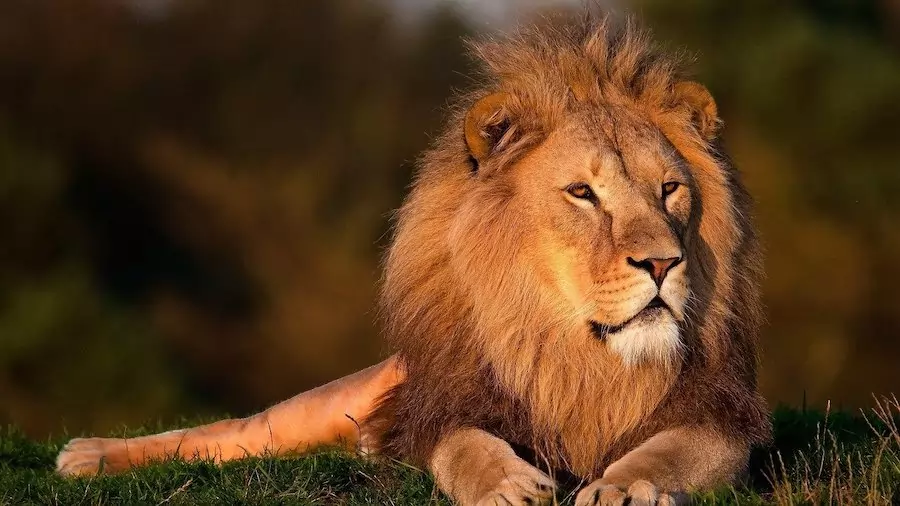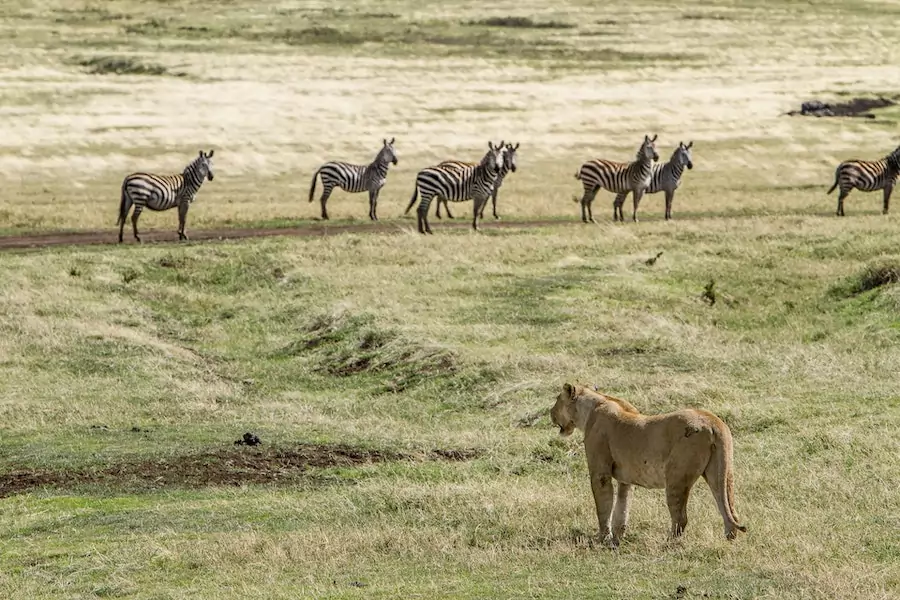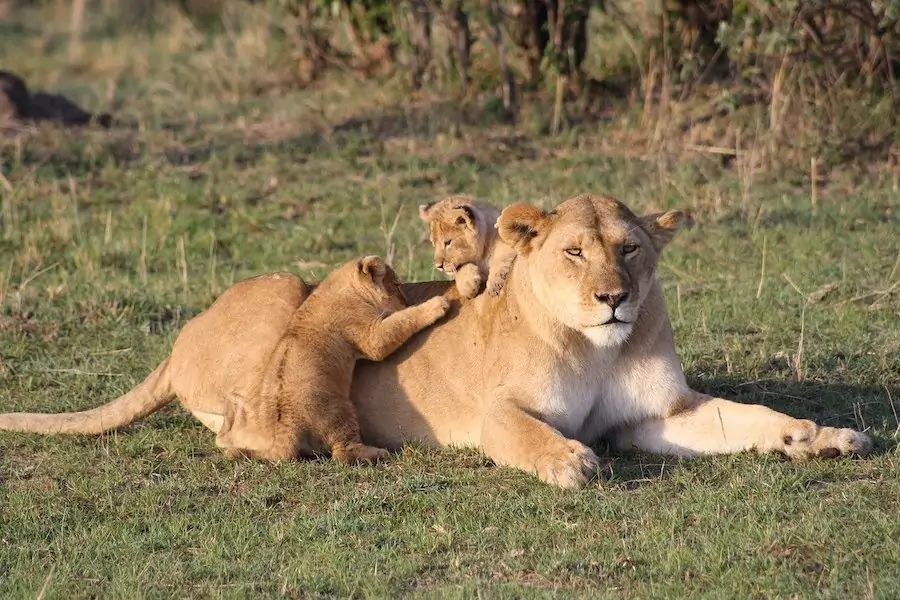Here we’re going to take you through the top 17 facts about lions that you should know. Some quick-fire facts about lions around their size and weight, their communication, roles within groups of lions, and about lion cubs.
Facts about lions
Let’s get into the list of 17 facts about lions…
1. Lions are members of the cat family
Lions are of the order Carnivora, in the family Felidae. All lions fall within the species Panthera leo with a range in sub-Saharan Africa and India. This is the “family” of big cats, including tigers, jaguars, and leopards.
Lions are the second-largest feline in the world after tigers and are either white or tawny colored which refers to the color of their fur.
There are several different and somewhat contested types of lions. Lions in Africa are ‘savannah’ lions while Indian lions are referred to as ‘Asiatic’ lions. The list of (non-extinct) lions types are:
- Katanga lion
- Congo Lion
- Transvaal lion
- Barbary lion
- East African lion
- Asiatic lion
- West African lion
2. Lions have been around for a long time
Lions have existed for at least 1.5 million years, and in that time they haven’t changed much in physical appearance. They were over twice as large as today’s lions, and at that time were not restricted to Africa.
Lion numbers have been dwindling over the past few centuries with the recent population being less than 20,000.
3. Most lions live in Africa
Africa is the predominant and ideal climate for lions. Although some live outside of Africa in zoos, reserves, etc.
Statistically, about 20,000 – 25,000 lions are left living in the wild (in Africa) while there are around 700-850 lions in North American zoos.
Facts About Lions – Distribution map
So as lions are said to be the king of the jungle, do lions actually live in the jungle?
4. Males can weigh up to 500 pounds
The average weight of a male adult lion is around 330 pounds (about 150 kilograms) with an average length of 8 to 9 feet long.
But they have been known to reach a height of 7 feet, a weight of 500 pounds (about 225 kilograms), and a length of 11 feet.
5. Lions sleep up to 20 or more hours per day
Most lions sleep around 18-20 hours a day but can be active at any time during the day or night.
They spend about 2-3 hours awake every day and around half an hour of that time hunting for their food. The reason for this, in part, is that they prefer to avoid the heat of the day.
Adult lions have been known to spend up to 2 whole days asleep at a time due to their large size and weight.

6. Lions have excellent vision
Lions have excellent eyesight which allows them to be the apex hunters they are.
It’s believed they can see up to 5 miles away at night, and about 2-3 miles away during the day.
Lions have a vision that is eight times further than a human’s vision, allowing them to spot and focus on a rabbit or other animal at a distance of about two miles.
While we humans can see a candle flame at that distance, a small animal camouflaged in its surroundings would be hidden from us.
They also have very good hearing and sense of smell.
7. A Lion’s roar can be heard for miles
Lions have a powerful roar that is known to be able to carry for up to 5 miles away.
A lion’s roar is the loudest sound made by any animal with a similar-sized voice box, or any other terrestrial animal for that matter.
Their roar is a way of marking their territory by voicing their dominance over an area.

8. Lions favor grasslands and plains
Lions typically live in open areas where their prey are likely to live or travel through in abundance. savannas or grasslands rich in vegetation. They favor grasslands and plains, semi-arid deserts, and sparse woodlands.
9. Lions are carnivores
Lions are mostly meat-eaters, but they do eat some plants and fruit when they need to.
They prey on large mammals such as wildebeests, zebras, and buffalo, but also eat smaller mammals such as hares or antelopes.
Check out our Article on what lions eat, giving the full list of What lions eat.

10. Lions do not have a mating season
Lions show no obvious signs when they are ready to mate, and it often occurs in completely unguarded moments.
for this reason, lions breed throughout the year, although there may be a slight trend of breeding at certain times in certain areas of their range due to rainfall and local food availability.
Adult males participate in the rearing and protection of cubs, although younger adult male helpers assist in providing food for the small cubs.
Cubs stay with their mother for about two years until she is ready to have another litter.
11. Lions are social animals
Lions mostly live within a group called a pride. A pride typically consists of about 2-30 lions. A pride can consist of 1-4 males and up to three times as many females.
Socially, lions are more complex than many other cat species.
Lions can afford to be sociable because, unlike other big cats such as tigers and leopards, they have no strong competitors for territory or food.
The lion’s social life is also driven by sexual desire: an individual’s access to sex often determines its place in the social hierarchy.
12. The lion mane is their most distinctive physical feature
Male lions distinguish themselves from the females by developing a mane and thicker skin around their neck and head.
The lion’s mane is the thick “hair” that sits around its head. This mane has many functions, including some evidence suggesting it attract females during mating season. the darker the mane, the more females a male lion is thought to attract.
The mane is also likely to enhance the lion’s appearance, making it look bigger and promoting aggressive behavior when males fight each other.

13. Lions are becoming less endangered
Historically, lions numbers have been in decline. In some areas, conservation efforts show that recent trends for some endangered lion species have been positive, and show lion numbers are actually increasing in Africa (between 30-100% in most of their African range).
Their biggest threat is still habitat loss due to farming, deforestation, and general human conflict.
14. Lionesses do most of the hunting
The lion is the second-largest living feline species (only tigers are bigger).
The lioness does most of the hunting for food as lions do not like to undergo exercise; although they are stronger, male lions tend to prefer prey that is easy to catch.
Lionesses are able to judge if their prey can be caught easily, and will not undertake the hunt if the chances of success are low.
The lioness will typically bring her kill back to her pride for them all to share. If food is scarce, the lioness might have to leave her pride in search of food for her and her cubs.

15. Lions cannot roar until one year old
Up till the age of one, male lion cubs cannot roar and instead make a purring sound. This is to avoid alerting prey without realizing that danger may be close. Female cubs are able to roar within a few months beyond one year of age.
They start to practice their roars as little as 4 months old to sound more like adults.
16. Lion cubs can run within days of birth
Within as few as three days from birth, lions cubs are able to run up to speeds of 15 mph. An adult lion can run at 50 mph.
Cubs are normally weaned until they are about six months old, although they can eat meat as soon as one month old. The cubs begin to eat meat regularly when the lioness brings her prey back to the den after killing it.
And so, lionesses protect their young by leaving them in an abandoned aardvark or warthog burrow, while they go out hunting for food.
They will only return from hunting to the den and abandon the hunt if there is a high threat of attack from another animal, such as the risk from an intrusive male lion.

17. Lions communicate verbally and non-verbally
Lions can make up to twenty different sounds including “grunts, groans, growls, snarls, meows, and hisses”.
They’re are also known for their purring. However, this is not always for the purpose of communication because it can be used as a form of self-comforting behavior.
Facts about Lions – Lion information summary table
The following table outlines the summary information about the lion species.
| Species | Panthera leo |
| Types | Katanga lion, Congo Lion, Transvaal lion, Barbary lion, East African lion, Asiatic lion, West African lion |
| Habitat: | Savannas, Grasslands, Open woodlands, Semi-arid desert, Scrubland |
| Location: | Sub-Saharan Africa – Angola, Mozambique, Botswana, Tanzania, South Sudan, Central African Republic |
| Lifespan: | 10 – 15 Years |
| Size: | 4.6 – 8.2 ft (1.4 to 2.5 m) |
| Weight: | 265 – 500 pounds (120 – 220 kg) |
| Color: | Mostly tawny brown, to rare white coloring |
| Diet: | Carnivorous: Including small to large ungulates, and wild game |
| Predators: | Hyenas, Leopards predating mostly cubs |
| Top Speed: | 80 Kph (50 Mph). Lions cubs 15 mph |
| Conservation Status: | Vulnerable to recovering for some |
More Information and facts about lions
We hope this has helped to provide some awesome and valuable facts about lions. Be sure to check out more articles we have on lions, such as whether lions attack giraffes. And if lions eat other lions.

